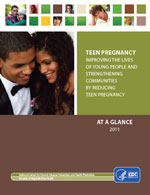- Teen Pregnancy The Importance of Prevention
- Vital Signs Preventing Teen Pregnancy in the US
- CDC-TV A Message to Health Care Professionals
The Importance of Prevention
In 2010, a total of 367,752 infants were born to women aged 15–19 years, for a live birth rate of 34.3 per 1,000 women in this age group. This is a record low for U.S. teens in this age group, and a drop of 9% from 2009. Birth rates fell 12% for women aged 15–17 years, and 9% for women aged 18–19 years. In addition, teen birth rates declined for all races and for Hispanics in 2010. While reasons for the declines are not clear, teens appear to be less sexually active, and more of those who are sexually active appear to be using contraception than in previous years.
Teen Pregnancy Prevention Topics
About Teen Pregnancy
Teen pregnancy and childbearing bring substantial social and economic costs through immediate and long-term impacts on teen parents and their children.
Teen Pregnancy Prevention 2010–2015
CDC is partnering with the Office of the Assistant Secretary for Health to reduce teenage pregnancy and address disparities in teen pregnancy and birth rates.
Parent and Guardian Resources
Your teen needs your help in understanding his or her feelings, peer pressure, and how to say no if he or she does not want to have sex.
For Health Care Providers
As a health care provider, you play a critical role in further reducing teen pregnancy rates through the care you provide to your adolescent patients.

Teen Pregnancy and Social Media
Take advantage of CDC social media tools to promote your teen pregnancy prevention efforts. A number of social media tools with credible, science-based teen pregnancy prevention messages are available. These free, easy-to-use communication tools can expand the reach of your health messages and help increase public engagement.
Guidance Publications
Promoting Science-Based Approaches to Teen Pregnancy Prevention Using Getting to Outcomes [PDF - 312KB]
This program has developed a clear process for building the capacity of our national, regional, and state-level grantees. Grantees give tailored trainings and technical assistance to their local partners who deliver science-based teen pregnancy prevention programs at the community level. The process is called Promoting Science-Based Approaches to Teen Pregnancy Prevention Using Getting to Outcomes (PSBA-GTO) and is described in this document. It integrates the guidance and tools for program planning, implementation, and evaluation and is designed for the teen pregnancy prevention field.
Get email updates
To receive email updates about this page, enter your email address:
Contact Us:
- Centers for Disease Control and Prevention
1600 Clifton Rd
Atlanta, GA 30333 - 800-CDC-INFO
(800-232-4636)
TTY: (888) 232-6348 - New Hours of Operation
8am-8pm ET/Monday-Friday
Closed Holidays - cdcinfo@cdc.gov





